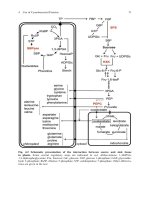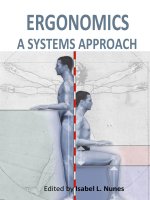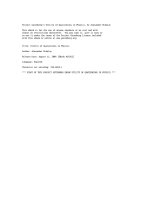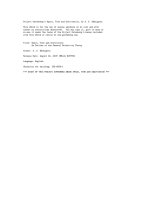Molecular biology, a project approach s karcher (AP, 1995)
Bạn đang xem bản rút gọn của tài liệu. Xem và tải ngay bản đầy đủ của tài liệu tại đây (12.51 MB, 303 trang )
MOLECULAR BIOLOGY
A Project Approach
This Page Intentionally Left Blank
MOLECULAR BIOLOGY
A Project Approach
SUSAN J. KARCHER
Department of Biological Sciences
Purdue University
West Lafayette, Indiana
ACADEMIC PRESS
San Diego New York Boston
London Sydney Tokyo Toronto
This book is printed on acid-flee paper.
Copyright 9 1995 by ACADEMIC PRESS, INC.
All Rights Reserved.
No part of this publication may be reproduced or transmitted in any form or by any
means, electronic or mechanical, including photocopy, recording, or any information
storage and retrieval system, without permission in writing from the publisher.
A c a d e m i c Press, Inc.
A Division of Harcourt Brace & Company
525 B Street, Suite 1900, San Diego, California 92101-4495
United Kingdom Editionpublished by
Academic Press Limited
24-28 Oval Road, London NW 1 7DX
Library of Congress Cmaloging-in-Publication Data
Karcher, Susan J.
Molecular biology : a project approach / by Susan J. Karcher.
p.
cm.
Includes index.
ISBN 0-12-397720-7 (paper)
1. Molecular biology--Laboratory manuals. 2. Molecular biology-Experiments. I. Title.
QH506.K367 1995
574.8'8'078--dc20
94-20816
CIP
PRINTED IN THE UNITED STATES OF AMERICA
95 96 97 98 99 00 EB 9 8 7 6 5
4
3
2
1
To the students.
This Page Intentionally Left Blank
CONTENTS
METHODS LOCATOR
xiii
SUGGESTED SCHEDULE OF LABORATORY PROTOCOLS
PREFACE
xv
xvii
ACKNOWLEDGMENTS
NOTE TO USERS
xix
xxi
1
TRANSPOSON MUTAGENESIS OF Escherichia coli
Introduction to Transposons
1
Advantages of Transposon Mutagenesis
Eukaryotic Transposable Elements
8
Transposons and Gene Fusions
9
Preparing for Laboratory Exercises
9
Common Laboratory Rules
9
Guidelines for Laboratory Notebooks
Guidelines for Laboratory Reports
Using Micropipettors
11
Review of Sterile Technique
12
6
10
11
VII
viii
CONTENTS
Tn5 Mutagenesis of Escherichia coil and Analysis of
Auxotrophs: Overview
15
Strain List
Media Recipes
15
17
Protocol 1.1: Phage ~ Titer
19
Protocol 1.2: Making a Phage Stock--Growing X-TnS'
Part A: Making Fresh Plaques
21
21
Part B: Making Phage Lysate Stocks
23
Protocol 1.3: Transposon Mutagenesis Using ~::TnphoA'-2
25
Introduction to Auxotrophs
27
Protocol 1.4: Isolation of Auxotrophs--Replica Plating, Toothpicking,
or Screening on 2 EM Plates
27
Protocol 1.5: Identification of Auxotrophs on Pool Plates
31
Making Pool Plates
31
Protocol 1.6: Analysis of Auxotrophs Using a
Literature Search
33
Genetic Mapping Strategies
References
35
S u g g e s t e d Reading
36
34
2
R E C O M B I N A N T DNA CLONING
Introduction to Recombinant DNA Technology
Cloning Vectors
49
pBR322
52
Vectors That Yield Single-Stranded DNA
Development of the pUC Plasmids
56
Vectors for Cloning Large DNA Fragments
Restriction Endonucleases
63
Type I or Class I Restriction Endonucleases
Type II or Class II Restriction Endonucleases
Type III or Class III Restriction Endonucleases
Other Restriction Endonucleases
70
45
54
60
65
66
70
The Use of Restriction Endonucleases: Practical Matters
Different Restriction Endonucleases
Setting Up a Restriction Digestion
Stopping a Restriction Digestion
Ligase
77
Gel Electrophoresis
78
73
73
76
71
ix
CONTENTS
Structure of Agarose
79
Pulsed Field Gel Electrophoresis
Capillary Electrophoresis
84
84
Ethidium Bromide Staining of DNA in Gels
85
Ethidium Bromide Safety
86
Sensitivity of Detection with Ethidium Bromide
Other DNA Stains
87
Transformation
88
Background
88
Transformation Procedures
90
Recombinant DNA Cloning: Overview
Description of pUC Vectors
93
/3-Galactosidase
93
87
92
The Insert DNA to Be Cloned: Origin and Significance of
Cosmid 203
95
Alternative DNAs to Clone
96
Recombinant DNA: P1 Level of Physical Containment-Laboratory Practices
97
Protocol 2. l a (Optional): Restriction Digestion of DNA Samples and
Gel Electrophoresis of DNA Samples
97
Protocol 2.1 b (Optional): Restriction Enzyme Digestion of
DNA to Be Cloned
98
Protocol 2.2 (Optional): Gel Electrophoresis
99
Protocol 2.3: Large-Scale Plasmid Isolation Using
Alkaline Lysis
102
Determination of DNA Concentration
109
Protocol 2.4: Recombinant DNA Cloning
110
Schedule for Recombinant DNA Cloning Experiment
110
Restriction Digestions for Cloning
111
Bacterial Transformation
114
Protocol 2.5a: Competent Escherichia coli Cells
116
Preparing and Freezing Competent Cells
116
Protocol 2.5b: Preparing Fresh Competent Escherichia coil Cells
for Transformation
117
118
Protocol 2.5c: A Rapid Colony Transformation Procedure
Protocol 2.6a: Boiling Mini-Prep Isolation of Plasmid DNA
Protocol 2.6b: Alkaline Mini-Prep Procedure for Isolating
Plasmid DNA
121
References
123
Suggested Reading
131
Using Competent Cells for Transformation
119
120
X
CONTENTS
3
SOUTHERN BLOT ANALYSIS
Southern Blot Introduction
135
Using Southern Blot Analysis to Map Restriction
Endonuclease Sites
136
Nonradioactive Labeling of Nucleic Acids
136
Horseradish Peroxidase and Enhanced Chemiluminescence
137
Digoxigenein Nonradioactive Labeling System
138
Biotin-Streptavidin Labeling System
139
Chromogenic Substrate for Alkaline Phosphatase
141
Chemiluminogenic Substrate for Alkaline Phosphatase
141
Autoradiography: Overview
143
Isolation of Nucleic Acid Fragments from Gels
145
Labeling Methods
147
Nick Translation
147
Oligo Labeling
150
Photobiotin
152
Hybridization to Membranes
153
Blot of a Dry Gel
155
The Attachment of Nucleic Acids to a Membrane
156
Protocol 3.1 a: Southern Blot
157
Modifications of Standard Blotting Procedures
160
Mini-Southern Blotting
160
Protocol 3.1 b: Bidirectional Blotting: A Sandwich Blot
161
Protocol 3.1 c: Alkaline Blotting
161
Protocol 3.1 d: Colony Hybridization
162
Protocol 3.2: Isolation of DNA Fragments by Electroelution
164
Overview
164
Preparation of Dialysis Tubing
167
Labeling DNA to Be Used as Probes
169
Protocol 3.3a: Labeling Probe with Biotin Using
Nick Translation
169
Separation of the Biotin-Labeled DNA from the Uncorporated
Biotin-14-dATP by Exclusion Chromatography Using a
Sephadex G-100 Column
170
Protocol 3.3b: Oligo Labeling of a Probe
171
Protocol 3.3c: Protobiotin Labeling of a Probe
173
Protocol 3.4a: Hybridization and Detection of Labeled Probe--A
Biotin-Labeled Nonradioactive Probe and
Chromogenic Substrate
174
xi
CONTENTS
Hybridization for a Chromogenic Nonradioactive
Detection System
174
Detection of a Biotin-Labeled Probe for a Chromogenic Nonradioactive
Detection System
176
Protocol 3.4b: Hybridization and Detection of Labeled Probe--A
Biotin-Labeled Nonradioactive Probe and
Chemiluminogenic Substrate
178
Additional Notes about Nonradioactive DNA
Detection Systems
184
Protocol 3.5: Standard Southern Blot Hybridization with
32p-Labeled Probe
187
References
189
Suggested Reading
192
4
PLANT GENOMIC SOUTHERN BLOTTING WITH PROBES FOR LOW- AND
HIGH-COPY-NUMBER GENES
Overview of Experiment
193
193
Protocol 4.1: Plant DNA Extraction Mini-Prep Procedure
"Reconstructions" for Gels
196
Protocol 4.2: Steps of a Genomic Southern Blot
199
References
200
Suggested Reading
200
Genomic Southern
195
5
RNA PURIFICATION AND NORTHERN BLOT ANALYSIS
RNA Introduction: Overview of Experiment
202
Protocol 5. I : R N A Extraction from Plant Leaves
203
Protocol 5.2: Separating Poly(A) § RNA from Total
Cellular RNA
206
Batch Elution
206
Protocol 5.3: RNA Gel: A Denaturing Formaldehyde Gel
207
Protocol 5.4: A Northern Blot
208
Protocol 5.5: Standard Northern Blot Hybridization Conditions for
32p-Labeled Probe
210
Xll
CONTENTS
,m
Protocol 5.6: Nonradioactive Biotin-Labeled Probes for
Northern Blots
213
References
213
Suggested Reading
213
6
POLYMERASE CHAIN REACTION
Background
215
Protocol 6.1" PCR Experiment
References
223
Suggested Reading
224
219
APPENDIX 1" Templates for Streaking Colonies
229
APPENDIX 2: Storing Bacterial Strains: Making Permanents
APPENDIX 3: Reporter Genes
235
APPENDIX 4: Antibiotic Information
APPENDIX 5: X-gal and IPTG
239
247
APPENDIX 6: More Information on Molecular Biology Protocols
APPENDIX 7: Sources of Strains
APPENDIX 8: List of Suppliers
APPENDIX 9: Additional Information
251
253
257
APPENDIX 10: Molecular Weight Standards
GLOSSARY
INDEX
261
275
231
259
249
METHODS LOCATOR
Alkaline Blotting, 161
Alkaline Mini-Prep Procedure for Isolating Plasmid DNA, 121
Auxotroph Analysis by Literature Search, 33
Auxotroph Identification on Pool Plates, 31
Auxotroph Isolation--Replica Plating, Toothpicking, or Screening on 2
EM Plates, 27
Bacterial Transformation, 114
Bidirectional Blotting: A Sandwich Blot, 161
Biotin-Labeled Probe and Chromogenic Substrate, 174
Biotin-Labeled Probe and Chemiluminogenic Substrate, 178
Colony Hybridization, 162
Colony Transformation (Rapid), 119
Competent Escherichia coli Cells for Transformation, 116
DNA Concentration Measurement, 109
DNA Fragment Electroelution, 164
DNA Gel Electrophoresis, 99
Gel Electrophoresis of DNA, 99
Genomic Southern Blotting, 199
Large-Scale Plasmid Isolation Using Alkaline Lysis, 102
Micropipettors, 11
XUl
xiv
METHODS LOCATOR
Nick Translation Labeling of Probe with Biotin, 169
Nonradioactive Biotin-Labeled Probes for Northern Blots, 213
Northern Blotting, 208
Northern Blot Hybridization Standard Conditions for
32poLabeled Probe, 210
Oligo Labeling of a Probe, 171
PCR Experiment, 219
Phage )~ Titer, 19
Phage Stock Preparation~Growing )~-Tn5', 21
Photobiotin Labeling of a Probe, 173
Plasmid DNA Mini-Prep Isolation, 120
Plant DNA Extraction Mini-Prep Procedure, 195
Plasmid Isolation MaxioPrep Using Alkaline Lysis, 102
Poly(A) § RNA Separation from Total Cellular RNA, 206
Recombinant DNA Cloning, 110
Restriction Digestion of DNA Samples and Gel Electrophoresis of
DNA Samples, 97
Restriction Enzyme Digestion Excercise of DNA to
Be Cloned, 98
RNA Extraction from Plant Leaves, 203
RNA Gel: A Denaturing Formaldehyde Gel, 207
Sephadex G-100 Exclusion Chromatography, 170
Single-Colony Isolation, 12
Southern Blotting, 157
Southern Blot Hybridization Standard Conditions for
32poLabeled Probe, 187
Sterile Technique, 14
Transposon Mutagenesis Using )~::
TnphoA'-2, 25
SUGGESTED SCHEDULE OF
LABORATORY PROTOCOLS
Week
Day 1
Day 2
Day 3
1
Review: Use of
micropipettors; sterile
technique; streaking for
single colonies
Protocol 1.2 Part A
Protocol 1.2 Part B
2
Protocol 1.3
Protocol 1.3
3
Protocol 1.5;
Protocol 2.1a
4
Protocol 2.3 ~
5
Protocol 2.4 c
6
Protocol 2.6a or b
7
Protocol 3.1a
Protocol 3.1a
Protocol 3.2e;
Protocol 3.3a, b, or c
Protocol 3.4a or bf;
hybridization
Protocol 3.4a or b;
posthybridization
washes
Protocol 3.4a or b;
detection of probe
9
Protocol 4.1
10
Protocol 4.2
11
Hybridization of blot
from Protocol 4.2;
using Protocol 3.4a or b
12
Protocol 5.1
Day 4
Protocol 1.2 Part B,
starting at step 10;
Protocol 1.1
Protocol 1.4
Protocol 1.6a; Protocol
2.1b; Protocol 2.2
Protocol 2.3, continued
Protocol 2.4; ligation
Protocol 2.4;
transformation d
Protocol 2.4
completion
Protocol 2.6a or b
Protocol 4.1
Protocol 4.2
Posthybridization washes;
using Protocol 3.4a or b
Detection of probe; using
Protocol 3.4a or b
Protocol 5.1 and
Protocol 5.2
(continues)
xv
xvi
SUGGESTED SCHEDULE OF LABORATORY PROTOCOLS
(continued)
Week
Day 1
13
Protocol 5.3;
Protocol 5.4
14
H y b r i d i z a t i o n of blot
from Protocol 5.4;
u s i n g Protocol
3.4a or b
15
Protocol 6.1
Day 2
Day 3
Day 4
Protocol 5.6 g
Posthybridization
washes; using
Protocol 3.4a or b
Detection of probe;
using Protocol 3.4a
or b
A n a l y s i s of results of
Protocol 6.1 by gel
electrophoresis;
using Protocol 2.2
~ Protocol 1.6 is continued by students outside the scheduled lab.
b For a course of less than 15 weeks, the instructor may wish to demonstrate Protocol 2.3 to the students.
c The timetable for Protocol 2.4 can be varied, depending on whether a one-hour or an overnight ligation is used.
d The competent cells needed in Protocol 2.5 are prepared using Protocol 2.5a or 2.5b. The instructor may wish to prepare
frozen competent cells for the students. Alternatively, if the students will prepare their own competent cells, this may be
done in Week 4 (for frozen cells, Protocol 2.5a) or in Week 5, Day 2 and 3 (for fresh cells, Protocol 2.5b).
e For a course of less than 15 weeks, the instructor may wish to omit Protocol 3.2.
f Alternatively, Protocol 3.5 may be used.
g Alternatively, Protocol 5.5 may be used.
PREFACE
I hear, and I forget,
I see, and I remember,
I do, and I understand.
Ancient Chinese Proverb
This manual of experiments is intended for beginning students who have
a basic understanding of genetics and molecular biology, but who may
not have had any laboratory experience in these areas. Included is an
extensive introduction and a large amount of background material so that
this text might "stand alone" without the need of a second textbook for
the laboratory course. I have also included an extensive bibliography so
students may learn more about areas that have piqued their interest.
This manual is based on the laboratory class in molecular biology
and molecular genetics I have taught to undergraduate juniors and seniors
and masters students at Purdue University in the Department of Biological
Sciences since 1982. The approach I have used in teaching the molecular
biology laboratory at Purdue has been to have students perform multipart
projects, with parts that build on each other, rather than to have the
students perform a new exercise each laboratory period. It is that projectoriented approach that I bring to this manual.
Susan J. Karcher
West Lafayette, Indiana
.e
XVll
This Page Intentionally Left Blank
ACKNOWLEDGMENTS
I am very grateful for the support and understanding of my family: Stan,
Matthew, Brandon, and Sarah Gelvin. I also acknowledge my extended
family: Franklin, Hilda, and Barb Karcher, Phil and Dolly Gelvin, and my
friend Becky Wong. I thank former teaching assistants: Dr. Brad Goodner,
for his contributions to the chemiluminescent DNA detection experiment,
and Dr. Bill Metcalf, for essential input in modifying the transposon mutagenesis experiment. I thank Dr. Mark Levinthal, for early input into the
transposon mutagenesis experiment, and Dr. Barry Wanner, for some of
the transposon mutagenesis strains. I acknowledge help with the PCR
exercise from Dr. Sergei Filichkin, Mr. Chris Fusco, and Dr. Vibha Gupta.
I thank Ms. Chris Baugher for all her efforts at the keyboard. I thank Dr.
Stan Gelvin especially for his careful examination of the manual in all its
various forms including the final version. I am very grateful to Dr. Lorraine
Lica, editor, of Academic Press, for all her input, encouragement, and
support. I thank my many colleagues in the Department of Biological
Sciences at Purdue University. I thank wholeheartedly all my students
over the years who have tested these experiments, whose excitement about
and keen interest in these topics have made teaching this class such a joy,
and whose questions have led to the refinement and improvement of this
manual.
I greatly appreciated the book by W. B. Wood, J. H. Wilson, R. M.
Benbow, and L. E. Hood, "Biochemistry: A Problems Approach" (The
Benjamin/Cummings Publishing Co., Menlo Park, CA, first and second
Eds.), the source of the ancient Chinese proverb in the preface.
xix
This Page Intentionally Left Blank
NOTE TO USERS
Although an effort has been made to indicate the precautions necessary
when handling certain materials used in the procedures of this manual,
the individual using this manual must assume all responsibility for the
correct use of materials.
xxi
This Page Intentionally Left Blank
*l
TRANSPOSON MUTAGENESIS OF
Escherichia coli
Introduction to Transposons
A transposon is a genetic entity that promotes its own movement or
transposition; it can insert as a discrete segment of DNA into many different
sites in the genome.
In the 1940s, Barbara McClintock's pioneering studies on the genetics of pigment variation in maize kernels first indicated the existence of
transposable elements. Such elements were understood on a molecular level when bacterial insertion sequences (IS elements) were isolated
and characterized in the late 1960s. The discovery of insertion sequences
showed that rearrangements can occur within the bacterial genome and
sometimes result in alterations in gene expression. At the time of this
discovery, the genome was thought to be a very stable entity. IS elements
were first found in studies of gene expression in Escherichia coli as
highly polar, rather unstable mutations in the galactose and lactose opo
erons and in bacteriophage )~ early genes (Galas and Chandler, 1989).
Analysis of hybrid DNA molecules (heteroduplexes) in the electron microscope showed that these mutations resulted from the insertion of the
same few segments of DNA into different places of the genome. These
elements, subsequently called insertion sequences, were shown to be
present in the wild-type E. coli genome as well; the elements move to
new locations and generate mutations as they insert into active genes.
IS elements vary in copy number from a few to a few hundred in
different organisms, are common on naturally occurring plasmids, and
are often found associated with antibiotic resistance genes (Tables 1.1
and 1.2).
2
TRANSPOSON MUTAGENESIS OF Escherichia coli
Table 1.1
Insertion Sequences
Name of
element
Size
(bp)
IS/
IS3
ISIO
IS50
IS66
768
1258
1329
1534
2548
Inverted
repeats (bp)
2O/23
29/40
17/22
8/9
18/20
Target
duplications (bp)
9 (8-11)
3
9
9
8
Source
E. coli
E. coli
R100 (Tnl0)
Tn5
A. tumefaciens
Source: D. J. Galas and M. Chandler (1989).
Table 1.2
Transposons
Name
Antibiotic
resistance
Size
(kb)
Structure
Insertion specificity
mode of transposition
Tn3
Ampicillin
5
No IS elements; 38-bp
inverted repeats
Prefers to insert in AT-rich region; transposes
at high frequency into plasmids, at low
frequency into chromosome; replicative
transposition; 5-bp target duplication
Tn5
Kanamycin
Bleomycin
Streptomycin
5.8
1.5-kb IS50 elements
as inverted repeats,
19-bp inverted
repeats important
for transpostion
Random insertions; occasional hot spots; highfrequency transposition nonreplicative
transposition; 9-bp target duplication
Tn9
Chloramphenicol
2.6
0.8-kb I S / a s direct
repeats
Inserts in many sites, insertional hot spots;
9-bp (or 8-bp) target duplication
Tnl0
Tetracycline
9.3
1.3-kb ISIO elements
as inverted repeats;
23-bp inverted
repeats important
for transposition
Inserts in many sites, insertional hot spots;
9-bp target duplication
Mu
Immunity to Mu
37.5
2-bp inverted repeats
important for
transposition
No IS elements, 26-bp
inverted repeats
important for
transposition
No IS elements
No inverted repeats
Random insertion with some hot spots;
bacteriophage, transposes as part of phage
replication; 5-bp target duplication
Tn916 Tetracycline
Tn554
Erythromycin
Spectinomycin
Source: Berg eta]. (1989).
16.4
6.7
Conjugative transposon; transfer 10 -8 to 10 -5
per donor; no target site duplication
Transposes by site-specific recombination to
att554 site; no target site duplication









